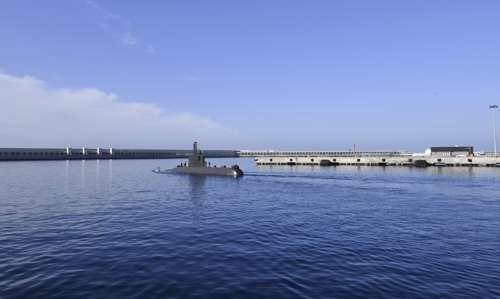S. Korea's underwater forces combat ready against N. Korea
By YonhapPublished : Sept. 17, 2017 - 13:28
The South Korean Navy's submarine SSK Lee Eok Gi (SS-071) wobbled a bit, setting sail from the country's newest naval port on Jeju Island.
The slight odor of oil that filled the cramped, windowless diesel-electric sub made some of the strangers aboard worry about getting seasick.
"This is (like) a lake," Cdr. Kang Byung-oh, the captain of the 1,200-ton sub, told a small group of reporters in the torpedo room, which doubles as a briefing room, last week. "The waves are only about 1.5 meters high. When we came here yesterday from Jinhae (in South Gyeongang Province), they were 5 meters high."

The sub soon shifted to a "snorkel navigation" mode to operate submerged while taking in air from above the water.
The captain checked the outside of the sub via a periscope, conveying information to other crew members.
He then shouted, "Prepare for underwater navigation." The crew repeated this loudly.
The civilian visitors were asked to be quiet. A submariner explained that it's one of the most tense moments.
"Water (tank) full," Kang shouted again, and so did the other submariners. It meant that with the sub's internal tank full of water, it had entered full underwater operation.
The depth gauge showed 41 meters below water.
"We are in waters 5 miles south of Jeju Island," the captain said. Five miles is 8 kilometers.
The Lee Eok Gi, named after a Joseon Dynasty (1392-1910) naval commander, is the Navy's ninth and last 209-class submarine, and was built as part of the Chang Bo Go project.
Delivered to the Navy in 2001, it's armed with Harpoon missiles, submarine mines and more than a dozen torpedoes -- both South Korea-made Baek Sang Eo (white shark) and German SUT guided ones.
The submarine took part in the Rim of the Pacific Exercise (RIMPAC), a US-led, Hawaii-based international naval training event held in 2010. It's capable of sailing back and forth between South Korea and Hawaii without fuel supply.
An alarm rang abruptly to mark the simulated appearance of an enemy submarine about 16 km away.
The Lee Eok Gi launched an SUT torpedo, which scored a direct hit.
A separate fire control drill was held that involved a scenario with flames in the starboard section of the stern.
The 56-meter-long, 5.5-meter-wide sub carries a total of 40 crew members -- seven commissioned officers and 33 non-commissioned ones.
"It takes one year to train a submarine crew. That's why there are no conscripts here," a submariner said. A South Korean conscript serves in the military for about two years.
The 40 crew share 34 tiny double-deck bunks and two small toilets.
"It's true that we serve in a relatively bad environment. But I am very proud of being a member of a team that plays an important role in the defense of our sea," he said.
South Korea's Navy has nine other 1,800-ton submarines, compared with 70 to 80 submarines reportedly operated by the North, which is developing submarine-launched ballistic missiles.
The South's Navy plans to introduce 3,000-ton submarines starting in 2020. It also hopes to have nuclear subs.
"If we have the assets, it will bring an epoch-making change to our tactics. (Submarines are) faster than ships and can carry out successive underwater operations for much longer," the captain said. "For instance, we will be able to carry out so-called 'search and sprint' operations."
In a recent parliamentary session, Defense Minister Song Yong-moo said, "The time has come: we need nuclear submarines."
His ministry has already begun a study on the feasibility of acquiring nuclear subs amid a controversy over the potential diplomatic impact.
Meanwhile, the construction of the Jeju Naval Base off the southern coast of the semi-tropical island started in 2006 and was completed last year despite strong protests by local residents and activists.
Formally dubbed the Jeju Civilian-Military Complex Port, it can accommodate more than 20 warships and two 150,000-ton cruise liners at the same time. A huge cruise terminal is also under construction there. (Yonhap)


















![[KH Explains] Hyundai's full hybrid edge to pay off amid slow transition to pure EVs](http://res.heraldm.com/phpwas/restmb_idxmake.php?idx=652&simg=/content/image/2024/04/18/20240418050645_0.jpg&u=20240418181020)

![[Today’s K-pop] Zico drops snippet of collaboration with Jennie](http://res.heraldm.com/phpwas/restmb_idxmake.php?idx=642&simg=/content/image/2024/04/18/20240418050702_0.jpg&u=)